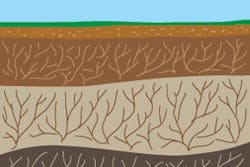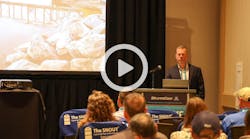Cost-Effective Erosion Control With Blankets and Mats – Part 5
Flat Ground and Mild Slopes
Erosion control blankets are used in Texas only on newly graded and seeded slopes of 3:1 or steeper, and Mason estimates that such slopes comprise only about 20–30% of the areas TxDOT grades and seeds each year. For flatter areas, the workhorse solution is hay or straw mulching. As Mason and Bowers explain it, after the soil has been graded and prepared for seeding with a chisel plow, a tractor pulls a range grass drill across the land. Doing so automatically discs a trench in the soil, plants grass seed, and covers the soil back up. Rather than blowing seed onto the soil, in recent years TxDOT has increasingly seed-drilled because of the higher survivability of such seed. After the fertilizer is spread, a hay/straw-mulching machine makes its way across the ground, automatically grinding a bale of hay or straw and blowing it 20–100 feet onto the field.
In the past, asphalt emulsion was often sprayed to bind the hay or straw fibers, but that sometimes proved damaging to the finishes of nearby cars. TxDOT now uses a machine that rolls over the hay or straw and crimps the fibers, thereby forcing fibers into the ground to anchor them. TxDOT avoids placing nylon nets over the mulch because it involves considerable labor and is costly.
Bowers notes that hydromulching has been used for more than 15 years in Texas, especially in urban areas where the ground is uneven (e.g., in the depression around a culvert or the uneven ground of a median strip) or in other areas where it is difficult to maneuver a tractor. In such unlevel areas, it is not possible for TxDOT to use its very cost-effective workhorse method for temporarily protecting newly graded areas–namely the hay-/straw-mulching method described earlier.
“True,” says Bowers, “hydromulching involves one operation and hay/straw mulching involves several. But the productivity rate is much higher with hay/straw mulching. Even with a 2,000-gallon hydromulching tank, a worker can only cover a relatively small area. On the other hand, with hay/straw mulching using a tractor and appropriate equipment towed behind, a worker can seed and mulch much larger areas. Furthermore, the mulch usually used in hydromulching operations, recycled newspapers, is not as effective as hay or straw in holding moisture in the soil. Our experience at Texas DOT indicates that hydromulching costs about $800 an acre versus $430 an acre for the hay/straw mulching. [To put] things in a broader context, the installed cost for a roll-on erosion control blanket on a slope ranges in Texas from $1.64 to $3.69 per square yard.
TxDOT has been experimenting with using compost from numerous dairy farms, mixed in with wood fibers, as a mulch for protecting newly graded and seeded areas. From time to time, Texas is stricken with droughts, putting hay in short supply. The compost, which could be applied by a manure spreader, could be a very effective substitute to the usual straw or hay mulch. Bowers anticipates that compost will be used extensively in Texas in the years ahead as mulch for newly seeded areas, especially in rural areas. Many farmers have far more compost on hand than they can use, and thus would be glad to get rid of the stuff. Other states with substantial dairy operations might also benefit from this approach. Details on TxDOT’s work in this area are available at www.dot.state.tx.us/compost.
For channel lining, TxDOT generally installs permanent TRMs in channels that have a gradient between 2% and 10%—wherever the shear force created by the flowing water is greater than 2 pounds per square foot. “We may install a permanent turf-reinforcing mat when the ditch gradient is 2%, but we definitely will put one in when the ditch gradient is 5% to 7%,” says Mason. These reinforcing mats may work well in ditches with as steep a gradient as 8% to 10%. But for ditches with a 7% gradient or greater, the stormwater-flow velocities are usually too high even for reinforced turf, so for such situations, TxDOT installs a more durable material, such as riprap or a concrete liner.


